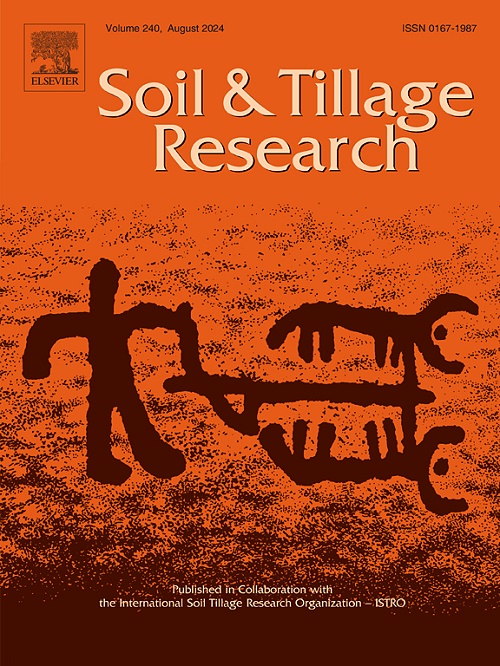中国东北地区玉米气候适宜性及保护性耕作技术实施策略研究
IF 6.1
1区 农林科学
Q1 SOIL SCIENCE
引用次数: 0
摘要
保护性耕作是一种兼顾土地保护与利用的有效种植制度。然而,它的无差别推广可能导致诸如玉米发芽延迟、产量降低和土壤结构恶化等问题。以往的研究主要集中在气候变化对东北地区玉米种植气候适宜性的影响上,很少考虑保护性耕作引起的土壤温湿度变化对玉米气候适宜性的影响。此外,缺乏考虑不同地区具体特征的针对性保护性耕作实施策略。因此,本研究将保护性耕作对土壤湿度和温度的影响作为环境变量进行量化。应用MaxEnt模型对东北黑土区保护性耕作条件下玉米气候适宜性进行了模拟。此外,创新性地提取了该地区典型的地形地貌特征,并提出了具有区域特色的保护性耕作实施策略。结果表明:(1)保护性耕作对土壤湿度和温度有显著影响。当秸秆盖度达到30 % ~ 95 %时,土壤水分增加0.04 ~ 0.13 m³ /m³ ,土壤温度降低0.15 ~ 0.46℃,影响玉米气候适宜性分布。(2) 2000—2020年,东北地区保护性耕作玉米气候适宜面积呈上升趋势,增加12.6 × 10⁴km²,平均适宜面积为96.2 × 10⁴km²。(3)秸秆覆盖免耕技术适宜推广面积为47 × 10⁴km²,占适宜总面积的48.8% %。适宜实施高茬垄侧植技术的面积为24 × 10⁴km²,占适宜总面积的25 %。推广秸秆覆盖垄作少耕技术的适宜面积为10.9 × 104 km²,占适宜总面积的11. %。适宜实施高茬行间直播技术的面积为8.6 × 10⁴km²,占适宜总面积的9 %。研究结果为保护性耕作的科学推广和区域实施提供了理论支持,对实现粮食生产与耕地保护的协调发展具有重要意义。本文章由计算机程序翻译,如有差异,请以英文原文为准。
Study on climate suitability for maize and technical implementation strategies under conservation tillage in Northeast China
Conservation tillage is an effective planting system that balances land conservation with utilization. However, its indiscriminate promotion may lead to issues such as delayed maize germination, reduced yields, and soil structure deterioration. Previous studies have primarily focused on the impact of climate change on the climate suitability for maize cultivation in Northeast China, with little consideration of how changes in soil moisture and temperature due to conservation tillage affect maize climate suitability. Moreover, there is a lack of targeted conservation tillage implementation strategies that consider the specific characteristics of different regions. Therefore, this study quantifies the impact of conservation tillage on soil moisture and temperature, using these factors as environmental variables. The MaxEnt model was applied to simulate maize climate suitability under conservation tillage in the black soil region of Northeast China. Additionally, the study innovatively extracted typical topographic and geomorphological features of the region and proposed region-specific conservation tillage implementation strategies. The results indicate that: (1) Conservation tillage significantly impacts soil moisture and temperature. When straw coverage reaches 30 % to 95 %, soil moisture increases by 0.04–0.13 m³ /m³ , while soil temperature decreases by 0.15–0.46°C, thereby influencing the distribution of maize climate suitability. (2) Between 2000 and 2020, the area of climate suitability for maize under conservation tillage in Northeast China has shown an upward trend, increasing by 12.6 × 10⁴ km², with an average suitable area of 96.2 × 10⁴ km². (3) The area suitable for promoting straw mulching no tillage technology is 47 × 10⁴ km², accounting for 48.8 % of the total suitable area. The area suitable for implementing high stubble ridge side planting technology is 24 × 10⁴ km², making up 25 % of the total suitable area. The area suitable for promoting straw mulching ridge tillage with minimal tillage technology is 10.9 × 104 km², accounting for 11 % of the total suitable area. The area suitable for implementing high stubble inter-row direct seeding technology is 8.6 × 10⁴ km², making up 9 % of the total suitable area. The results of this study provide theoretical support for the scientific promotion and region-specific implementation of conservation tillage, which is of great significance for achieving coordinated improvement of grain production and farmland conservation.
求助全文
通过发布文献求助,成功后即可免费获取论文全文。
去求助
来源期刊

Soil & Tillage Research
农林科学-土壤科学
CiteScore
13.00
自引率
6.20%
发文量
266
审稿时长
5 months
期刊介绍:
Soil & Tillage Research examines the physical, chemical and biological changes in the soil caused by tillage and field traffic. Manuscripts will be considered on aspects of soil science, physics, technology, mechanization and applied engineering for a sustainable balance among productivity, environmental quality and profitability. The following are examples of suitable topics within the scope of the journal of Soil and Tillage Research:
The agricultural and biosystems engineering associated with tillage (including no-tillage, reduced-tillage and direct drilling), irrigation and drainage, crops and crop rotations, fertilization, rehabilitation of mine spoils and processes used to modify soils. Soil change effects on establishment and yield of crops, growth of plants and roots, structure and erosion of soil, cycling of carbon and nutrients, greenhouse gas emissions, leaching, runoff and other processes that affect environmental quality. Characterization or modeling of tillage and field traffic responses, soil, climate, or topographic effects, soil deformation processes, tillage tools, traction devices, energy requirements, economics, surface and subsurface water quality effects, tillage effects on weed, pest and disease control, and their interactions.
 求助内容:
求助内容: 应助结果提醒方式:
应助结果提醒方式:


